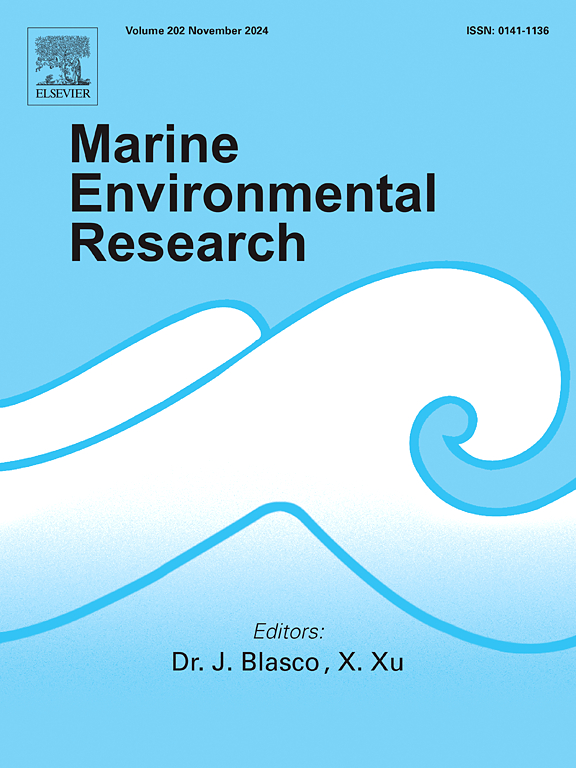海洋热浪对大闸蟹的影响:热应激恢复的生理生化机制
IF 3
3区 环境科学与生态学
Q2 ENVIRONMENTAL SCIENCES
引用次数: 0
摘要
海洋热浪(MHWs)的特征是海水温度长时间升高,对海洋生态系统构成重大威胁,特别是影响包括甲壳类动物在内的海洋生物的生理和行为。本研究研究了雄性和雌性大闸蟹在急性暴露于MHW后的生理生化反应,重点研究了能量代谢、氧化状态和潜在的神经毒性。将标本置于模拟温度从17°C升高到23°C的受控实验室条件下,分析鳃和肝胰腺的反应。结果显示了热应激恢复能力的性别差异,雄性在MHW暴露后表现出更高的鳃糖原储存,而雌性表现出糖原储备的显著减少和抗氧化酶活性的增加。在MHW下的雌性中,超氧化物歧化酶和谷胱甘肽还原酶活性显著升高,表明雌性对氧化应激的抗氧化反应更强。此外,作为神经毒性指标的乙酰胆碱酯酶活性在mhw后显著降低,暗示潜在的神经毒性作用。尽管存在这些生化变化,但脂质过氧化水平在两性和组织中都保持稳定,这表明短期MHW暴露不会对细胞膜造成显著的氧化损伤。这项研究强调了在评估气候变化引起的应激源对海洋生物的影响时考虑性别差异的重要性,因为雄性和雌性在应对热应激时表现出不同的代谢和生理策略。本文章由计算机程序翻译,如有差异,请以英文原文为准。

Impact of Marine Heatwaves on Carcinus maenas Crabs: Physiological and Biochemical Mechanisms of Thermal Stress Resilience
Marine heatwaves (MHWs), characterized by prolonged periods of elevated sea temperatures, pose significant threats to marine ecosystems, particularly affecting the physiology and behavior of marine organisms, including crustaceans. This study investigates the physiological and biochemical responses of males and females of Carcinus maenas crabs, after an acute exposure to an MHW, focusing on energy metabolism, oxidative status, and potential neurotoxicity. Specimens were exposed to controlled laboratory conditions simulating a temperature increase from 17 °C to 23 °C, and responses were analyzed in gills and hepatopancreas. Results revealed sex-specific differences in thermal stress resilience, with males showing higher glycogen storage in gills after MHW exposure, while females exhibited a significant reduction in glycogen reserves and an increase in antioxidant enzyme activity. Superoxide dismutase and glutathione reductase activities were notably elevated in females subjected to MHW, suggesting a more robust antioxidant response to counteract oxidative stress. Additionally, acetylcholinesterase activity, an indicator of neurotoxicity, was significantly reduced in females post-MHW, hinting at potential neurotoxic effects. Despite these biochemical changes, lipid peroxidation levels remained stable across both sexes and tissues, indicating that short-term MHW exposure did not cause significant oxidative damage to cell membranes. This study highlights the importance of considering sex differences in assessing the impacts of climate change-induced stressors on marine organisms, as males and females display distinct metabolic and physiological strategies for coping with thermal stress.
求助全文
通过发布文献求助,成功后即可免费获取论文全文。
去求助
来源期刊

Marine environmental research
环境科学-毒理学
CiteScore
5.90
自引率
3.00%
发文量
217
审稿时长
46 days
期刊介绍:
Marine Environmental Research publishes original research papers on chemical, physical, and biological interactions in the oceans and coastal waters. The journal serves as a forum for new information on biology, chemistry, and toxicology and syntheses that advance understanding of marine environmental processes.
Submission of multidisciplinary studies is encouraged. Studies that utilize experimental approaches to clarify the roles of anthropogenic and natural causes of changes in marine ecosystems are especially welcome, as are those studies that represent new developments of a theoretical or conceptual aspect of marine science. All papers published in this journal are reviewed by qualified peers prior to acceptance and publication. Examples of topics considered to be appropriate for the journal include, but are not limited to, the following:
– The extent, persistence, and consequences of change and the recovery from such change in natural marine systems
– The biochemical, physiological, and ecological consequences of contaminants to marine organisms and ecosystems
– The biogeochemistry of naturally occurring and anthropogenic substances
– Models that describe and predict the above processes
– Monitoring studies, to the extent that their results provide new information on functional processes
– Methodological papers describing improved quantitative techniques for the marine sciences.
 求助内容:
求助内容: 应助结果提醒方式:
应助结果提醒方式:


